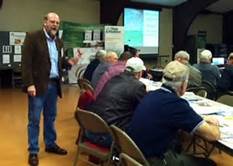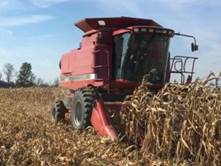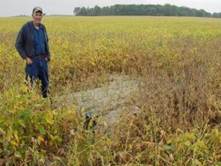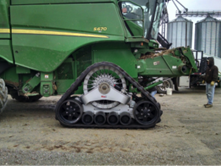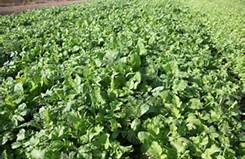Hello,
The number of fields with standing corn and soybeans have decreased in the past week around the county. Dry, cool weather helped corn harvest and field work continue at a slow pace, according to Cheryl Turner, Ohio State Statistician for the USDA’s National Agricultural Statistics Service. There were 3.8 days available for field work for the week ending November 26, 2017. Producers were able to enter fields when the soil dried enough late in the week or when the temperature fell below freezing. Average grain moisture for corn harvested was 19 percent. Winter wheat seedings are almost fully emerged and the condition remains 88 percent good to excellent. See the attached Ohio Crop Weather November 27 for more information from USDA about this past week in crops and weather.
Did you hear that the new dicamba changes for genetically engineered soybeans? The Environmental Protection Agency (EPA) announced an agreement with Monsanto, BASF and DuPont to change dicamba registration and labeling beginning with the 2018 growing season. EPA reports that the agreement was a voluntary measure taken by the manufacturers to minimize the potential of dicamba drift from “over the top” applications on genetically engineered soybeans and cotton, a recurring problem that has led to a host of regulatory and litigation issues across the Midwest and South. The upcoming changes might alleviate dicamba drift issues, but they also raise new concerns for farmers who will have more responsibility for dicamba applications. One of the new changes is that these dicamba products will now be restricted use which means you will need a pesticide license to apply these chemicals. I have attached an article about the new dicamba changes along with a flyer for an upcoming class for New Pesticide Applicator Training to be held next week in Auglaize County. I plan to offer a similar class this winter in Hardin County to train new pesticide applicators who are interested in obtaining their Ohio Pesticide License.
Did you either charge for custom farming or pay custom farm rates in 2017? If so, OSU Extension is now collecting data about what the current rates for custom farming are in Ohio. See the attached survey if you either charged or paid for custom farming operations. If you are willing to complete the survey and send it in, this will help provide data for 2018 Ohio Farm Custom Rates. This information is updated every two years and the current Ohio Farm Custom Rates can be found at https://farmoffice.osu.edu/farm-management-tools/custom-rates-and-machinery-costs. Speaking of machinery, do you have any old tractors that you would like to donate to charity? Courtney Fulton (daughter of Shelly Fulton who works in the Hardin County Extension office) is connected to Ronald McDonald House Charities and asked if I would let you know about this opportunity. If interested in a tractor donation to charity, see that attached flyer for more information.
There are mini 509 workshops called ‘From Farm Gate to Dinner Plate’ being offered in February for youth. February 17 will include Animal welfare, feeding practices, live animal evaluation, etc. February 24 will include Carcass grading and fabrication, retail identification, hands-on grilling session including food safety. The location of the workshops will be the OSU Animal Sciences Building in Columbus. If you know of a young person ages 14-18 years old (also adult advisors) who may be interested, please share the attached flyer with them as registration is coming due December 15. Upcoming local events include Ag Council breakfast that is scheduled for Friday, December 1 starting at 7:00 am at Henry’s Restaurant. The Fairboard will be meeting on Saturday, December 2 starting at 7:30 pm at the fair office. Next week there is a Cattle Producers meeting Monday, December 4 at Allmax Software starting at 7:30 pm. The Hardin County Ag Hall of Fame Banquet will be Tuesday, December 5 at St. John’s Evangelical Church in Kenton, staring at 6:30 pm. Farm Bureau is meeting the same evening, Tuesday, December 5 at Ag Credit staring at 7:00 pm. The Dairy Service Unit has a meeting scheduled for Wednesday, December 6 at the Extension office, starting at 7:00 pm. See below for some agronomy articles that you may be interested in reading.
Mark
Avoid costly problems in the spring by proper winterizing of your sprayer now – Erdal Ozkan
It is very likely that you will not be using your sprayer again until next spring. If you want to avoid potential problems and save yourself from frustration and major headaches, you will be wise to give your sprayer a little bit of TLC (Tender Loving Care) these days. Yes this is still a busy time of the year for some of you, but don’t delay winterizing your sprayer too long if you already have not done so. You don’t want a pump that is cracked and/or not working at its full capacity because you did not properly winterize it before the temperature falls below freezing. Here are some important things you need to do with your sprayer this time of the year. It is very likely that you did the right thing when you used the sprayer the last time: you rinsed the whole system (tank, hoses, filters, nozzles) thoroughly. If you did not, make sure this is done before storing the sprayer. A sprayer that is not rinsed thoroughly after each use, and especially after the spraying season is over, may lead to cross-contamination of products applied for different crops, and clogging of nozzles. Go to https://agcrops.osu.edu/newsletter/corn-newsletter/2017-37/avoid-costly-problems-spring-proper-winterizing-your-sprayer-now to finish reading this article.
Some Thoughts on Slugs – Kelley Tilmon and Andy Michel
As the 2017 field season winds down farmers are reflecting on how things went this summer and are looking ahead to next season. Many Ohio farmers experienced significant slug damage this spring and are thinking about future practices to mitigate slug damage including cover crops and crop rotations. We are conducting some preliminary on-farm research to look at the effect of different cover crops on slugs, but some interesting work has already been done by our colleague at Penn State, Dr. John Tooker. Tooker and his team have found that slug populations tend to be lower in more diverse rotations than the typical corn/soy rotation – the longer and more diverse the rotation schedule the better. Diversified rotations help promote a healthy field ecology where pests and predators can maintain a balance with each other. Ground beetles in particular are effective slug predators. Other practices which protect ground beetles have also been shown to help keep slugs down, for example avoiding insecticidal seed treatments or foliar applications unless they are warranted by pest-scouting and thresholds. Studies have shown that these insecticides harm beetle populations without harming the slugs and slug populations can actually increase. Dr. Tooker has also begun work with farmer-cooperators looking at “planting green” – planting corn or soybean into living cereal rye and terminating the cover slowly so that slugs have something to eat besides the cash crop. This is potentially a tricky approach so visit with somebody with experience in this approach if you want to give it a try. To learn more about slug biology and life cycles, visit our factsheet at https://ohioline.osu.edu/factsheet/ENT-20
West Ohio Agronomy Day – Debbie Brown
West Ohio Agronomy Day will be held on Monday, January 8th at St. Michael’s Hall in Fort Loramie (Shelby County), from 8:30 am-4 pm. This is our annual Recertification Program for Private Pesticide Applicators and will also include the one-hour Fertilizer Applicator Recertification Training for those who are already certified. In addition, there will be Continuing Education Units (CEUs) available for Certified Crop Advisers and Commercial Pesticide Applicator credits have been applied for. University presenters are Dr. Fred Whitford from Purdue University (Simple Application Techniques and Tactics that Work to Protect Crops and the Environment), Dr. Mark Loux (What you Need to Know about Problem Weeds: Marestail, Waterhemp, Palmer Amaranth, etc. and a Dicamba Update), Peggy Hall, JD (When Pesticides Drift: Who’s Liable? and Five Property Laws Farmers Need to Know), and Dr. Elizabeth Hawkins (Fertilizer Applicator Recertification). In addition, area Precision, Financial, and Marketing representatives, as well as ANR Educators, will be addressing other topics. Mark your calendars now to attend this “Food, Fun, Fellowship, and Lots of Information” event!! Watch for more news later!!
Ohio Certified Crop Adviser Pre-Exam Training Seminar – Harold D. Watters
The Certified Crop Adviser (CCA) Exam Training program, sponsored and delivered by the OSU Agronomic Crops Team, will be offered at the Shelby County Extension Office, 810 Fair Rd, Sidney, Ohio 45365 on January 10 & 11, 2018 beginning at 9:00 a.m. on the 10th and adjourn by 5:00 p.m. on the 11th. The price for the Pre-Exam preparation class is $250. Secure on-line registration via credit card, debit card or check is available at: http://www.cvent.com/d/jtqpf2. Register early; due to class interaction, we keep it small. This is an intensive two-day program somewhat directed toward the local exam – to be used as a reminder on what best to study in preparation for the CCA exams. To find out more details about this class for becoming an Ohio Certified Crop Adviser (CCA), go to https://agcrops.osu.edu/newsletter/corn-newsletter/2017-37/ohio-certified-crop-adviser-pre-exam-training-seminar.
Precision University: Nutrient Technology – Kaylee Port
Nutrient management is a major topic of conversation in agriculture. As Ohio struggles to improve water quality in Lake Erie, Grand Lake St. Mary’s, and rivers across the state, farmers are being pressed even harder to make better on-farm management decisions. This year, The Ohio State University Extension and the Digital Ag program team at OSU is hosting “Precision University: Nutrient Technology” as a way to highlight key nutrient management techniques and strategies. The January 11th workshop, to be held at Beck’s Hybrid’s, 720 U.S. 40 in London, Ohio, will feature speakers from both industry and academia who are experts in nutrient management technology. The event will also feature a panel discussion about equipment and technology for practical nutrient management, specialists in nutrient management, and special vendor presentations. To read more about this workshop, go to https://agcrops.osu.edu/newsletter/corn-newsletter/2017-39/precision-university-nutrient-technology.
Mark A. Badertscher
Agriculture and Natural Resources Educator
OSU Extension Hardin County
1021 W. Lima Street, Suite 103, Kenton, OH 43326
419-674-2297 Office
hardin.osu.edu


